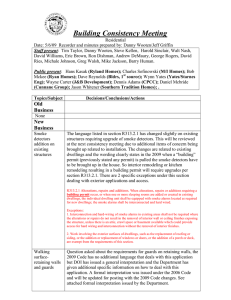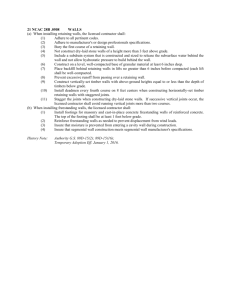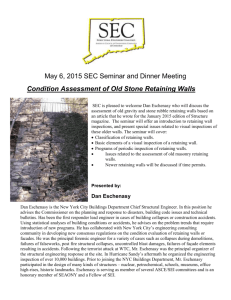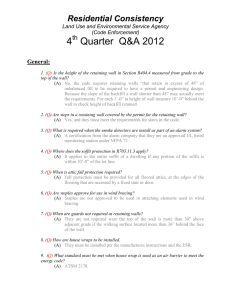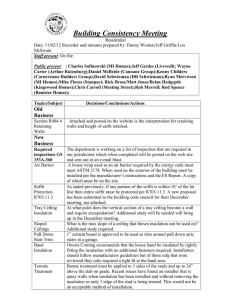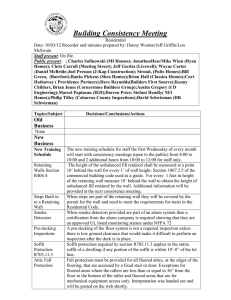Building Consistency Meeting
advertisement
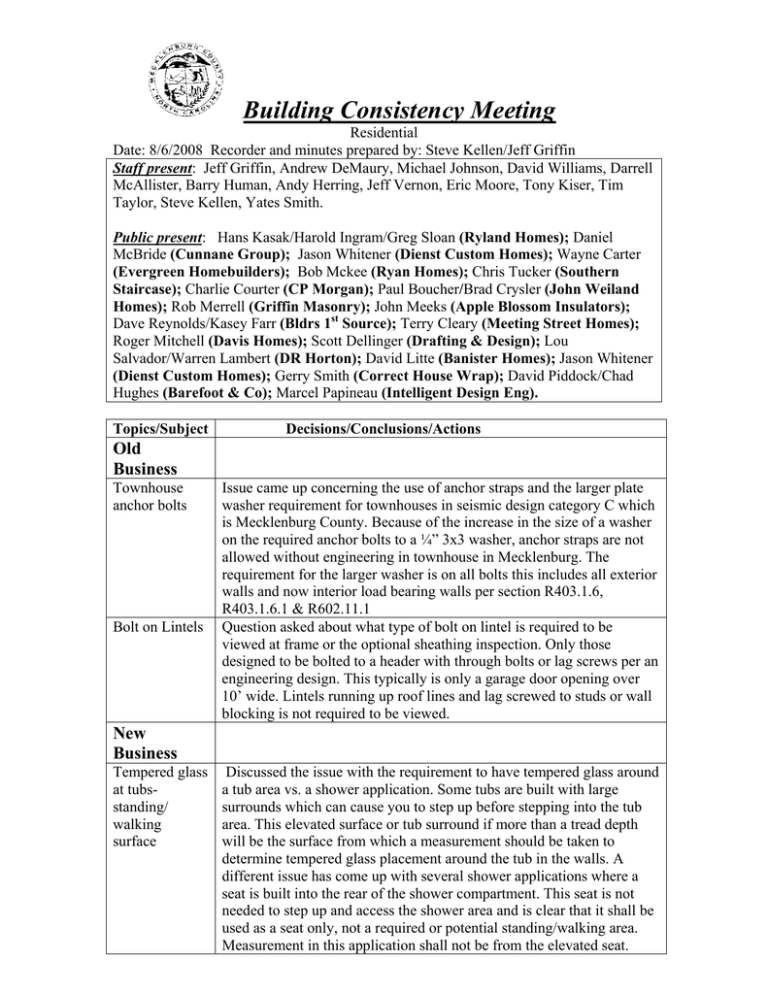
Building Consistency Meeting Residential Date: 8/6/2008 Recorder and minutes prepared by: Steve Kellen/Jeff Griffin Staff present: Jeff Griffin, Andrew DeMaury, Michael Johnson, David Williams, Darrell McAllister, Barry Human, Andy Herring, Jeff Vernon, Eric Moore, Tony Kiser, Tim Taylor, Steve Kellen, Yates Smith. Public present: Hans Kasak/Harold Ingram/Greg Sloan (Ryland Homes); Daniel McBride (Cunnane Group); Jason Whitener (Dienst Custom Homes); Wayne Carter (Evergreen Homebuilders); Bob Mckee (Ryan Homes); Chris Tucker (Southern Staircase); Charlie Courter (CP Morgan); Paul Boucher/Brad Crysler (John Weiland Homes); Rob Merrell (Griffin Masonry); John Meeks (Apple Blossom Insulators); Dave Reynolds/Kasey Farr (Bldrs 1st Source); Terry Cleary (Meeting Street Homes); Roger Mitchell (Davis Homes); Scott Dellinger (Drafting & Design); Lou Salvador/Warren Lambert (DR Horton); David Litte (Banister Homes); Jason Whitener (Dienst Custom Homes); Gerry Smith (Correct House Wrap); David Piddock/Chad Hughes (Barefoot & Co); Marcel Papineau (Intelligent Design Eng). Topics/Subject Decisions/Conclusions/Actions Old Business Townhouse anchor bolts Bolt on Lintels Issue came up concerning the use of anchor straps and the larger plate washer requirement for townhouses in seismic design category C which is Mecklenburg County. Because of the increase in the size of a washer on the required anchor bolts to a ¼” 3x3 washer, anchor straps are not allowed without engineering in townhouse in Mecklenburg. The requirement for the larger washer is on all bolts this includes all exterior walls and now interior load bearing walls per section R403.1.6, R403.1.6.1 & R602.11.1 Question asked about what type of bolt on lintel is required to be viewed at frame or the optional sheathing inspection. Only those designed to be bolted to a header with through bolts or lag screws per an engineering design. This typically is only a garage door opening over 10’ wide. Lintels running up roof lines and lag screwed to studs or wall blocking is not required to be viewed. New Business Tempered glass at tubsstanding/ walking surface Discussed the issue with the requirement to have tempered glass around a tub area vs. a shower application. Some tubs are built with large surrounds which can cause you to step up before stepping into the tub area. This elevated surface or tub surround if more than a tread depth will be the surface from which a measurement should be taken to determine tempered glass placement around the tub in the walls. A different issue has come up with several shower applications where a seat is built into the rear of the shower compartment. This seat is not needed to step up and access the shower area and is clear that it shall be used as a seat only, not a required or potential standing/walking area. Measurement in this application shall not be from the elevated seat. Landings at stairways Location on Lot vs. property lines Retaining wall guards Question asked about a variation in the riser heights in a flight of stairs broken up by landings. The code describes a flight of stairs as having a landing at the top and bottom so if there is a landing in a mid height between story levels then actually 2 flights of stairs have been created. Stair flights don’t have to be uniformed with each other only the risers and treads with a single flight. So if there was a variation between the risers in the first flight and the risers in the second that would still be 2 legal flights of stairs. Discussed the issue with townhouse, single family homes, decks and other detached accessory buildings like garages. DOI’s interpretation is that if a deck is built within 3’ of a property line then a solid 1 hour rated wall will have to be built from ground up to guardrail height. The other issue mentioned was a homeowner added to an older existing deck by enclosing with a roof and screening. The deck was grandfathered but because he added a roof and this screened porch was within 3’ of a property line a 1hour wall would be required from ground to roof. Follow up question asked about requirement for retaining walls to have guards on them. DOI only requires a guard when there is a dedicated walking surface adjacent to the retaining walls with more than a 30” drop off. The dedicated walking surface can be pavers, a driveway or sidewalk or even a gravel walkway or drive. Grass or yard adjacent to the retaining walls does not constitute a requirement for guards unless there is less than 36” between that retaining wall and walking surface. Department interpretation is attached that addresses how close a dedicated walking surface can be and a potential grade concern that could also play into requirement. DOI’s interpretation is listed below: The 2006 NC Residential Code, Section R101.2 states; “Accessory structures are not required to meet the provisions of this code except decks, gazebos and retaining walls as required by Section R404.1.3.” The NC commentary for this code section states; “All decks and gazebos require permits along with retaining walls per section R404.1.3.” In accordance with the above, and R404.1.3, it is my opinion that the following residential retaining walls require design and are therefore required to be permitted: 1. All retaining walls with an unbalanced condition exceeding 48 inches 2. All retaining walls that cross over property lines 3. All retaining walls that support buildings and their accessory structures The NC Residential Code, Section R312.1 states; “Porches, balconies, or raised floor surfaces located more than 30 inches (762 mm) above the floor or grade below shall have guards ...... in height.” The NC commentary for this section states: “The guard provisions of this code address the issue of providing protection for occupants from falling off of any elevated walking surface.” It is my opinion that guards (complying with R312) must be included on any of the above mentioned retaining walls when the finished area on the high side of the wall is more than 30 inches above the grade below and part of an egress route or other dedicated walking surface. I hope this is of assistance to you. David W. Conner, Sr., P.E. Building Code Consultant Office of State Fire Marshall NC Department of Insurance Appendix G Pool Barrier requirements Brought up the issue with Pools related to permits. Any person who pulls a permit for a new pool will also be responsible for the new barrier requirements listed under this new section of the code. There are several special technical requirements including the possibility of having to install alarms on house doors leading to pool areas. Pool permits cannot be passed unless there is a code compliant barrier in place at time of final. Emergency egress from basements Question asked about egress out of a basement area that only has storage in it. Section R310.1 Emergency escape and rescue required deals with basements that have habitable spaces and every sleeping room. When you look at the definition of habitable space or room you will see that storage is not considered habitable space. So if a basement has only storage such as a wine cellar then the steps leading to the basement area are sufficient to exit that space and no additional requirements are needed as listed in R310.
